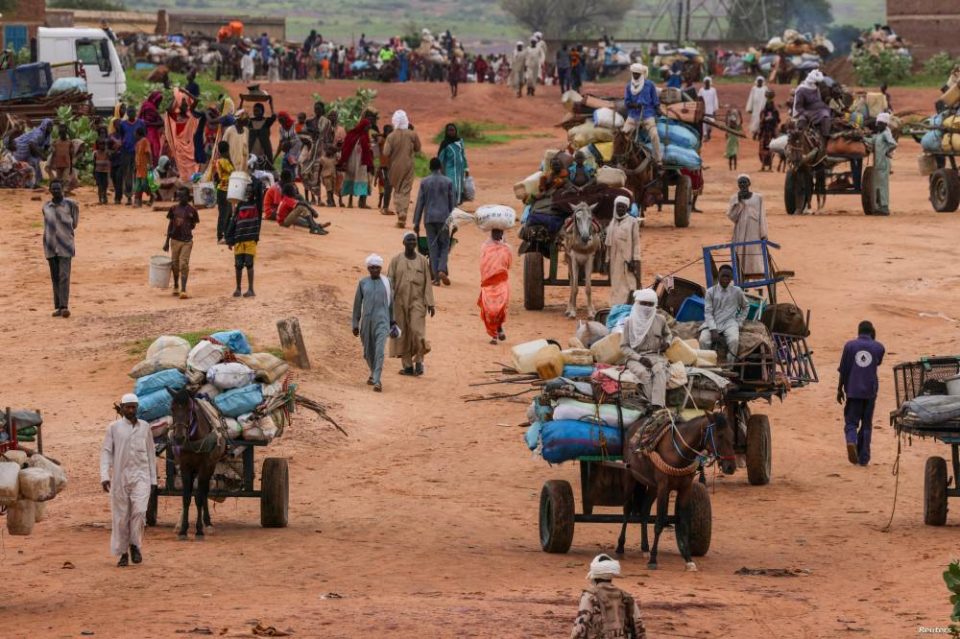The Sudanese civil war is brutal, devastating and shows no sign of coming to an end. It is fought principally between the Sudan Armed Forces, under the command of General Abdel Fattah al-Burhan, and the paramilitary Rapid Support Forces, headed by General Mohamed Hamdan Dagalo, known as ‘Hemedti’.
Hostilities erupted on 15 April, 2023. There is direct fighting between the two belligerents in the capital Khartoum, in Darfur and other parts of the country. The RSF is accused of atrocities against civilians, including killing, rape and pillage, while SAF aircraft have bombed civilian targets and critical infrastructure.
A risk of famine
The war has caused a humanitarian crisis of unprecedented size. According to United Nations figures from January 2024, of Sudan’s 45 million people, 5.9 million are internally displaced and 1.4 million have fled as refugees, with 25 million people in need of humanitarian assistance, with a looming food crisis and risk of famine.
The prospects for a democratic transition, so bright after the non-violent uprising that overthrew the long-standing military-Islamist regime of President Omar al-Bashir in April 2019, are buried in the rubble of Khartoum.
Sudan’s civilian movement has been scattered. Political parties are struggling to form a common platform. Many neighbourhood resistance committees, the backbone of the civic protests, have turned themselves into emergency groups for humanitarian services, while some have formed armed self-defence groups and others have disintegrated.
Sudan’s war is also a vortex of transnational conflicts and global rivalries that threaten to set a wider region aflame. From the Red Sea to the West Africa Sahel, from the Mediterranean to central Africa, neighbouring countries are affected by the flow of refugees, the movement of armed groups and the disruption of trade. South Sudan depends upon revenues from oil exports through a pipeline that crosses fiercely contested areas.
Most fighting in the civil war is directly between SAF and RSF but there are a number of other armed groups being drawn in, alongside new self-defence groups. The SAF is a quarrelsome coalition including Islamist securocrat veterans from the al-Bashir regime, who veto any moves by al-Burhan towards compromise with either Hemedti or the civilians.
The RSF is a novel amalgam of army, mercenary forces, trading conglomerate –notably in gold – and a vehicle for Hemedti’s political ambition. It shows indiscipline, with some RSF-aligned Arab militia pursuing local vendettas and land-grabbing and may fracture when its fighters run out of cities to loot.
A circle of conflicts
Sudan’s war is entangled in a circle of conflicts involving its African neighbours to east and west. The RSF originated in the infamous Janjaweed militia of Darfur, and recruits from nomads in Chad and Niger, its units active in Libya and Central African Republic. Egypt backs the SAF but wants to suppress the Islamist elements within it.
Meanwhile, Ethiopia’s aggressive pursuit of access to the sea has reconfigured East African alliances. Ethiopia is now allied with the RSF, while Eritrea aligns with SAF. Talks between Cairo and Addis Ababa over the Grand Ethiopian Renaissance Dam have broken down, raising fears of a proxy conflict. South Sudan, still economically dependent on relations with Sudan, is also vulnerable.
Sudan has become a cockpit in which the rising powers of the Middle East seek to project their power and gain an advantage over their rivals. Surpassing long-established actors such as Egypt and Saudi Arabia, as well as relative newcomers such as Iran, Qatar and Turkey, the United Arab Emirates is the most assertive intervenor, backing the RSF and providing arms and money to Chad and Ethiopia.
The wider Red Sea is an arena of geo-strategic contest where the embers are already smouldering for a wider war that drags in all the world’s main powers. Russia’s Wagner Group is an active military and commercial partner with the RSF – it is heavily invested in Sudan’s gold industry.
The looming crisis
The breadth of these complications has no precedent, but the contours of the looming crisis have been evident for some years. Sudan has wrestled for decades with the twin problem of an apparently bottomless economic crisis and governing an ethnically and religiously diverse nation.
The civilian-led cabinet headed by Abdalla Hamdok, formed after the 2019 civic revolution, could neither stabilize the economy nor loosen the military kleptocrats’ stranglehold over the most profitable sectors. Left to fend for themselves by international donors that failed to appreciate the urgency of a massive bailout, the democrats’ failure was preordained.
Al-Burhan and Hemedti jointly launched a coup in 2021. But the two generals couldn’t solve Sudan’s problems. They were just more ruthless in staying in power – by the same token sharpening the dispute between themselves.
Since civil war broke out last year, a succession of efforts to bring the warring parties to the negotiating table has failed. The United States–Saudi talks in Jeddah, an Egyptian initiative, and repeated efforts by northeast African leaders, have stumbled because of internal Sudanese veto or outside interference.
Conspicuously lacking is a mechanism for ensuring that the Middle Eastern powers – especially the UAE – come to the table with constructive proposals. The US has not raised its political engagement to a high-enough level for it to be taken seriously in Riyadh and Abu Dhabi.
It should not be difficult to reach a consensus across Africa and the Middle East that state collapse is in no one’s interest. A common goal of preventing the worst outcome should override differing preferences for who should lead the country.


